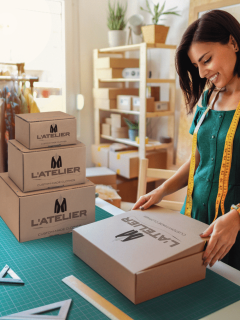“Made in Germany” continues to be in demand all over the world. 2018 ended with a record high for the German export industry. Companies exported goods worth almost 1.318 trillion euros. This corresponds to an increase of 3 per cent compared to the previous year, the Federal Statistical Office recently reported. Cars, machinery, electronics, medicines and plastic goods were particularly sought after by the rest of the world.
Producing the right goods for the world market is one thing, but shipping them in the right form is another. It is therefore important to choose the optimal export packaging in order to prevent damage or contamination. Because only the right packaging enables the safe and fast handling of goods. In addition to the protective function of a package, it must also meet all logistical requirements.
The export goods pass through many stations in the process: Logistics companies, forwarders, shippers and customers. And all of them expect the shipment to be handled easily and economically. In addition, there are export regulations that have to be taken into account: There are, for example, import duty rates, import regulations or preferential agreements of individual countries.
An initial overview for export enthusiasts is provided by checklists, such as those on getting started in the export business, which can be found in various versions on the internet. The overview page of the Limburg Chamber of Commerce and Industry in Hesse, for example, lists the most important aspects that need to be dealt with before exporting goods. This includes very practical things such as different voltages or plug variants when exporting electronic devices or the different clothing sizes and their conversion when exporting clothing.
How do I pack safely for shipping abroad?
10 tips for safe shipping abroad
In general, packaging always has the task of protecting the contents. When shipping goods abroad, this plays a particularly important role. The consignment is on the road for longer and is exposed to many more shocks and possibly also different climatic zones due to frequent loading. To ensure that the goods are delivered to the recipient undamaged, export packaging is the be-all and end-all. Even large and heavy goods must be packed in such a way that they are not damaged and do not cause any damage themselves.
With regard to packaging, there are definitely different expectations and regulations in other countries. While issues such as calibration laws (what information must be on the packaging?), common shapes or the symbolic content of colours therefore play a role for the packaging of consumer goods, other things such as transport route, climatic conditions, legal regulations and, last but not least, transport costs are relevant for export packaging.
Which export packaging is the right one in each individual case depends first of all on the country of destination. Hay, straw, but also wood are considered critical in many countries and may not be imported at all or only under strict conditions. Only when the wood packaging has been treated according to the IPPC standard(ISPM 15) is it considered harmless and can be imported.
Stacking packages of goods on a pallet reduces the risk of damage on the one hand and saves space and possibly transport costs on the other. In addition, palletising is advantageous for participants in the supply chain: the shipment can be easily transported with a pallet truck or forklift. The easy transport with machines saves both time and energy. The goods are bundled and delivered safely to their destination.
Containers made of corrugated cardboard are ideal for transport by road or rail, optionally already with an integrated pallet for fast loading and unloading. The advantages are, apart from the harmlessness due to wood pests, the relatively low costs and the low dead weight. This helps to save costs! Palletisable cardboard boxes also offer this advantage. Because they are standardised exactly to the pallet sizes, they form a homogeneous unit in the composite.
1st palletisation
Strapping is the term used to describe the securing of packaging units with a sealing strap: the goods are fixed in a slip-proof manner within a short period of time and thus offer greater transport safety. Strapping the units of goods together reduces the loss of units and makes it more difficult to steal individual packages. Depending on the package, strapping is done manually or automatically. Depending on the requirements on the straps, such as surface protection, flexibility or pliability, materials made of textile, plastic or steel are used.2. strapping
The goods should have as little space as possible in the packaging. This ensures that the contents are not damaged by sliding around in the shipping box. This is particularly important for large and heavy goods, as there is a risk of causing damage to other shipments.
The packaging size must be neither too large nor too small. Ideally, the product still has some space between it and the outer packaging. The cavities are filled with filling material and act as shock absorbers. Wrapping the goods in bubble wrap or foam packaging provides additional protection and avoids scratching the surface.
3. void fill
When exporting, the delivery can sometimes take a long time. Sometimes there is a problem with this: some objects react extremely sensitively to external influences. If wood is not properly cleaned, it rots and then provides the ideal breeding ground for parasites and bacteria. This creates the risk of infections and diseases being transmitted. So if goods or dangerous goods are not declared or packed as required, there is a risk that customs will detain the goods and impose a fine on the exporter and supplier. Before shipping, it is therefore worthwhile to check the shipping regulations for the goods being shipped. As a general rule, sources of moisture should always be examined to prevent possible resulting product damage such as rot.
4. consider shipping instructions
Potentially dangerous goods are divided into nine classes depending on the risk assessment:
- Class 1: Explosives and articles containing explosives, e.g. New Year’s Eve fireworks.
- Class 2: Flammable gas, non-flammable and non-toxic gas, toxic gas, e.g. spray cans.
- Class 3: Flammable liquids, e.g. adhesives, alcohol, perfume
- Class 4: Flammable solids, self-reactive substances, polymerising substances and desensitised explosive solids, e.g. oil, binzene and diesel filters or magnesium powder
- Class 5: Oxidising (flammable) substances, e.g. fertilisers.
- Class 6: Toxic substances and infectious substances, e.g. pesticides
- Class 7: Radioactive substances, e.g. probes, surface contaminated objects
- Class 8: Corrosive substances, e.g. sulphuric acid, hydrochloric acid
- Class 9: Miscellaneous dangerous substances and articles which do not fall into any other dangerous goods class, e.g. asbestos, lithium batteries, airbags.
Depending on the classification, there are regulations on packaging, marking, labelling and documentation. In order to avoid difficulties during shipping, it should first be found out whether the goods are considered dangerous goods and what measures should be taken in this case.
5. determine dangerous goods
Depending on the size of the goods, it is helpful to know the carrier’s pricing structure and weight restrictions. Restrictions usually only apply to very large and heavy items that cannot be palletised. But even with smaller goods, the charges increase with size and weight. It is worth researching, because often costs can then be saved by palletising differently, for example.
6. observe weight restrictions
When exporting goods from the European Union, various accompanying documents are required by the customs administration, the country of destination of the goods or the buyer:
- EORI number for export declaration
- Export declaration from 1,000 € or 1,000 kilograms
- Depending on the exporting country, accompanying documents must be enclosed, including commercial invoices, certificates of origin and import licences, to name but a few.
If you are not familiar with the procedure, it is advisable to seek advice from the competent Chamber of Commerce and Industry.
Whether and which export documents you need is listed on iloxx.de (DPD) for each country.
7. fill out all customs documents
In foreign business, it is often difficult to assess the risk of non-payment due to crises or economic downturns. This makes it all the more important to have export insurance to cover possible losses. If the payment of a
If a foreign business partner fails to pay, the German state steps in with Hermes cover. The risks and options should definitely be considered and calculated.
8. take out export insurance
An ATA Carnet is used when goods are only temporarily exported and re-imported. The procedure is tax-free and can be applied for at the Chamber of Commerce and Industry. The ATA Carnet is mainly used at trade fairs with international participation. Instead of individual national documents, it can be used for both export and re-import. Another advantage is the speedy border clearance. The savings in taxes and time make it worthwhile for many companies.
9. ATA carnet for temporary exports
In Germany there is a Din standard for correct addressing. But almost every country designs the address on parcels differently, here are some examples:
USA
Line 1 – Recipient
Line 2 – No. Street (type) (compass direction) (building) (floor) (flat)
Line 3 – City, Province, Zip Code
Line 4 – UNITED STATES
Japan
Line 1 – Recipient
Line 2 – (Building) (Apartment)
Line 3 – No. Street
Line 4 – Municipality
Line 5 – City, Province, Postcode
Line 6 – JAPAN
Mexico
Line 1 – Recipient
Line 2 – (Building) (Apartment)
Line 3 – No. Street
Line 4 – Municipality
Line 5 – City, Province, Postcode
Line 6 – JAPAN
To be on the safe side and to be reachable in case of discrepancies or queries, the contact details can be noted on the label.
10. address correctly
Good planning for exporting goods
In addition to the right export packaging and correct addressing, bureaucratic regulations and dangerous goods regulations also play a major role in market entry. Exporting goods involves a lot of planning and should only be tackled with sufficient lead time. But regardless of whether goods are being shipped domestically, to other European countries or to third countries: The same applies to all packages: the choice of packaging plays an important role in the success of the company.
















